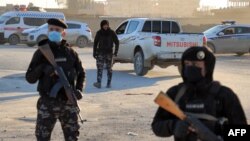On January 24, Ghassan Khalil, leader of Hasakah governorate in northeast Syria, told the Syrian newspaper al-Watan that the recent Islamic State (IS) attack on a major prison in the region was a ploy by the U.S. and its ally, the Kurdish-led Syrian Democratic Forces (SDF).
The goals, said Khalil, were to spread chaos and block agreements between the Syrian government and Arab leaders in northeast Syria. He noted that U.S. Deputy Special Envoy for Syria Matthew Pearl, along with SDF leaders, have met with Arab tribes and asked them to refrain from reaching an agreement with the Syrian state.
Four days earlier, more than 100 IS fighters attacked the Hasakah governorate’s al-Sina’a prison, also known as Ghuwayran prison, in a bid to free 5,000 IS-linked inmates. It took the U.S.-backed SDF 10 days to regain control and secure surrounding neighborhoods.
The IS attack was the group’s biggest since 2019. The Syrian Observatory for Human Rights (SOHR), a U.K.-based group, said 373 people died in the fighting, including 268 jihadists. The SDF said it lost 121 fighters, and the United Nations said 45,000 were displaced.
Khalil blamed the United States.
“What happened in al-Sina’a prison reveals an American attempt to recycle the Daesh [i.e., Islamic State] terror group,” he said, “especially after local and international calls to withdraw U.S. troops from Syria. This recycling serves to justify the presence of these troops in the area.”
That is false. Syrian officials have reiterated similar baseless claims that the U.S. is “recycling” IS. Syria and its ally, Russia, also have been battling IS fighters in government-controlled areas.
Syria’s envoy to the United Nations, Bassam Sabbagh, said on January 27: “United States occupying forces transferred ISIL/Da’esh [IS] terrorists from detention centres and recycled them, as demonstrated by recent events, attempting to provide an excuse for their presence in Syria …”
Last October, Syrian Foreign Minister Faisal Mekdad said some countries were using IS as a pretext to forward their “geopolitical agendas” in Syria. “The Syrian Arab Republic will face all kinds of aggression, occupation and terrorism from the U.S., Turkey and Israel,” Mekdad said.
Though weakened, IS has remained a threat since its defeat in March 2019. Sleeper cells continue to launch attacks worldwide. A day after the prison attack, IS targeted an army barricade in Iraq’s Diyala province, gunning down 11 soldiers as they slept.
On January 30, SOHR said Russian warplanes had launched 28 strikes against IS locations in the Syrian desert over 48 hours. Earlier in January, five Syrian soldiers were killed and 20 injured in an IS rocket attack that was followed by artillery shelling that targeted a military bus.
In this atmosphere of continued fighting, the prison attack highlights the troublesome issue of IS prisoners and family members who remain in detention. According to the U.N., tens of thousands of IS families live in refugee camps in northeast Syria. That includes 56,000 in the al-Hol camp.
Al-Sina’a prison was originally vocational high school; it was converted to hold IS fighters in 2017. It’s one of eight detention facilities in northeast Syria. Al-Sina'a held about 5,000 IS fighters, mostly high-ranking leaders from other countries. Occasional riots took place in the prison, most recently in August 2021, when IS inmates dug tunnels in a failed escape attempt.
Human Rights Watch (HRW) has reported dire conditions for thousands of IS men, women and children detained in Syria. Regarding the latest attack, HRW said:
“Recapturing the prison does not resolve the indefinite detention without due process of nearly 45,000 foreign ISIS suspects and family members, most of them young children, in deeply degrading, often inhumane, and life-threatening conditions in prisons and locked camps in northeast Syria.”
Vladimir Voronkov, head of the U.N. Office of Counter-Terrorism, said the attack at al-San’a underscored the problem of holding individuals without trial and the need to bring them to justice to break the cycle of violence. Voronkov called on U.N. member states to accelerate the repatriation so the prisoners could be prosecuted, rehabilitated and reintegrated to society.
The U.N. estimated that 700 children are being held in al-Sina’a.
“They are tragically being neglected by their own countries through no fault of their own except they were born to individuals allegedly linked or associated with designated terrorist groups,” said Fionnuala Ni Aolain, the U.N.’s special rapporteur on human rights.
HRW said only 25 out of 60 home countries have repatriated their nationals, and repatriation operations have been declining since 2019. The human rights watchdog said many countries who refrain from repatriating site security risks.
On January 30, U.S. National Security Advisor Jake Sullivan echoed calls for repatriation.
“The barbarity of [IS’s] actions during this attack reaffirms why this group must be denied the ability to regenerate and why nations must work together to address the thousands of ISIS detainees in inadequate detention facilities,” Sullivan said.
Since the defeat of IS, the U.S. has been scaling down its presence in Syria. Today, 700 U.S. troops remain as part of the Global Coalition’s effort to combat continuing IS threats.





